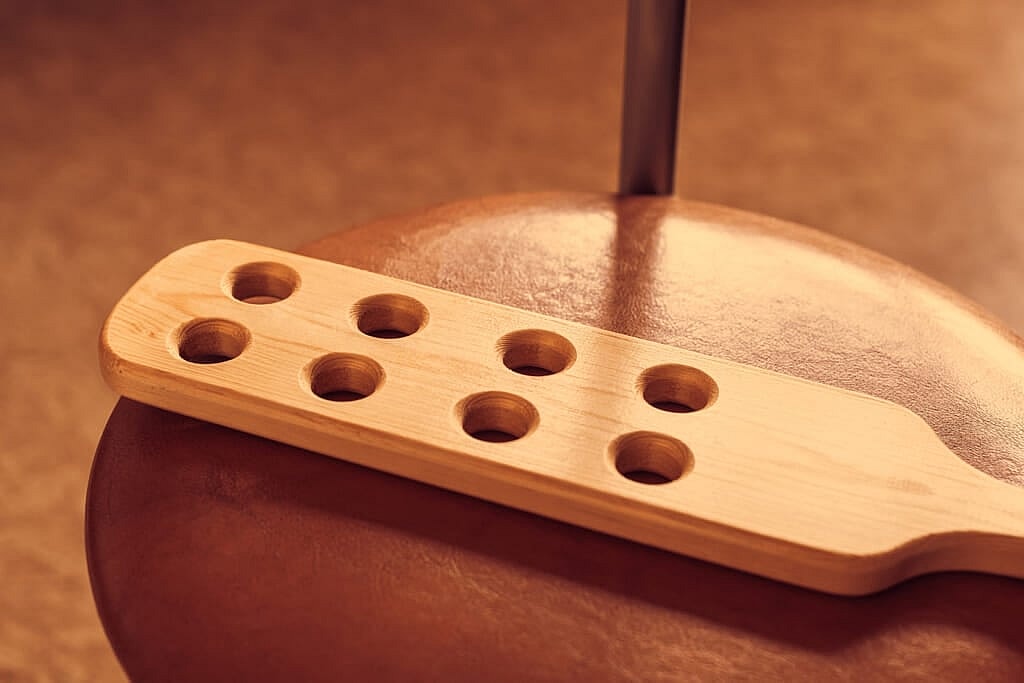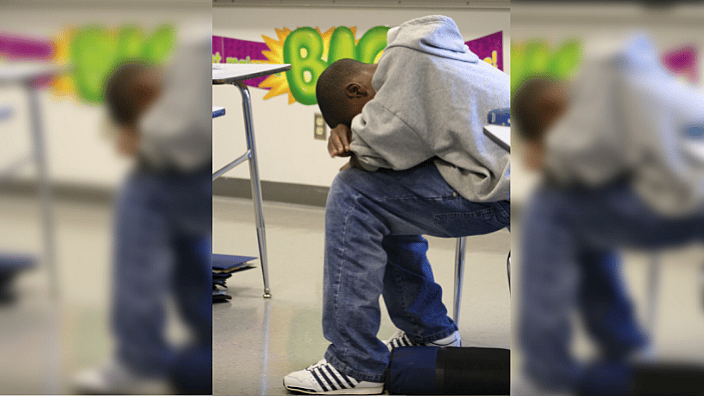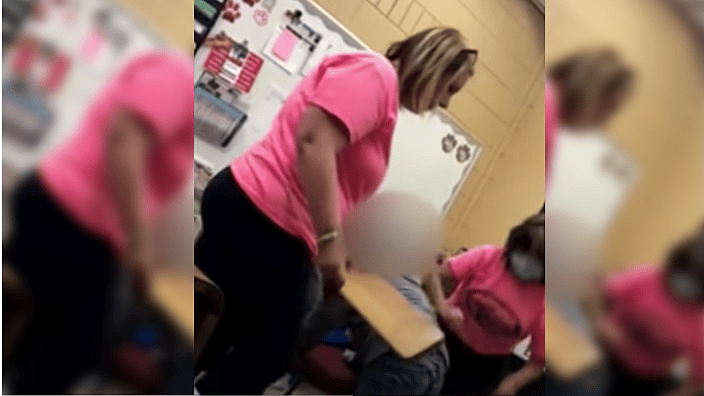Like Malcolm X once said, “only a fool would let his enemy teach his children.”
Especially a racist educational system where most teachers are white and female and school administrators and staff are allowed to punish children by hitting them with wooden paddles, and where educational outcomes for students of color are intentionally abysmal. Black students are more likely to be located in states that excessively use corporal punishment in schools and they are more likely to be singled out for paddling.
Make no mistake: this psychological and physical intimidation practiced by schools could not be sustained without support from parents of color. As a result, children all over the country are being maimed and psychologically impaired — especially students of color.
Quite frankly, this is exactly what a white supremacist system requires.
So it is no surprise to learn that the Florida principal who was caught on camera paddling a first-grade Latino student in front of her mother will not face any criminal charges. During the incident, which took place last month at the Central Elementary School in Clewiston, principal Melissa Carter berated the child for allegedly damaging a computer. Then as a school aide bent the child over a chair, Carter viciously hit her with a thick wooden paddle.
The child’s mother secretly recorded the incident on her cellphone. She said she did not intervene due to a language barrier and her undocumented status.
“The hatred with which she hit my daughter, I mean it was a hatred that, really I’ve never hit my daughter like she hit her,” the mother said in Spanish during an interview. Had she not recorded the incident, “nobody would have believed me,” she said. “I sacrificed my daughter so all parents can realize what’s happening this school.”
Carter was later investigated by the Department of Children and Families and the state attorney’s office, which reported that Carter had permission from the child’s mother to paddle her. The child’s mother has since retained an attorney.
We should be as skeptical about school administrators’ statements on corporal punishment as we are about police reports on violence against people of color. Whether or not this mother gave permission for her daughter to be paddled, this practice should never be an option in any school. We already have more than 50 years of research documenting how spanking harms children in their home environment. How could paddling these young students be considered beneficial in the school environment? What lessons are the children really learning?
Read More: Police berating boy, 5, spotlights abuse and neglect of Black children
Far too many people do not agree that allowing adult violence against children is toxic pedagogy that contributes to a negative school climate. On May 5, just a few days after the Florida paddling incident went viral, the Louisiana House rejected Bill 324, which would have banned the use of corporal punishment in public schools. In 2019, Louisiana students were paddled nearly 1,000 times. Opponents of the bill argue that the issue should be left to the state’s school districts.

Louisiana is one of five states that have banned corporal punishment of students with disabilities such as autism, speech or language impairment, developmental delays and emotional disturbance. But they continue to believe that hitting is good for other students despite research showing that spanking, even when it does not leave visible injuries, can harm a child’s brain development in ways similar to abuse.
Many people are surprised to learn that corporal punishment is still legal in public schools in 19 states, mostly in the south, and the practice is legal in private and charter schools in all but two states, Iowa and New Jersey. Punishment is typically delivered using wooden boards that are 2 feet long, 3 inches wide, and a half-inch thick. A total of 68,286 public school children were subject to corporal punishment in the 2017-2018 school year, according to data from the U.S. Department of Education’s Office for Civil Rights. Boys and children with disabilities are singled out more.
Last year in Florida, 1,034 students were subjected to corporal punishment. This week as controversy continued to stir over the Florida incident, one Republican state senator backed the practice.
“It’s all right to spank them, but don’t beat them. It’s OK if the intention is to teach them a lesson, but don’t leave no marks,” said Senator George Gainer. “There’s definitely a place for corporal punishment in the school system, but not beating. You have to know when to hit them and how hard to hit them. Once a child figures out you won’t spank them, you’ve lost all control.”

But the use of paddles, which sometimes have large holes drilled into them to cut wind resistance or are wrapped with tape to increase pain, has resulted in physical injuries to children — bruises, cuts, welts, broken blood vessels and bones. Some districts have an “immunity clause” which protects teachers and administrators from prosecution if a child is injured by paddling. One study found that nearly one in four adolescents who had received school corporal punishment reported that they suffered a bruise or other injury as a result. If a teacher or principal struck another adult on or off school grounds with a paddle it would be considered assault with a weapon.
Despite Sen. Gainer’s assertion, there is no scientific formula on how to appropriately hit a child in any context. It doesn’t matter who is doing the hitting or the intent. A child’s brain does not pause to distinguish between severe physical abuse, sexual abuse, or spanking and try to contextualize the intent behind the pain. That’s not how the brain works. All three are toxic stress events that flood the body with hormones. All three types of violence trigger a child’s autonomic fight-or-flight reaction which is naturally designed to protect against traumatic events.
When a child’s fight-or-flight response has been triggered, their hippocampus, which is responsible for decision-making and learning and is less developed in children, is not fully engaged with the rest of the brain. The primitive part of the brain takes over and the child takes in more information through their senses. The natural instinctive reaction is to flee, fight back, or freeze to give them the best chance of surviving a dangerous situation, including a parent with a belt or teacher or principal with a paddle.
Simply put, a child cannot learn and take in new information when they are afraid or experiencing pain. Hitting children is counter-productive to learning. The research shows that hitting children actually makes them more aggressive and disruptive over time. Additionally, children who experience corporal punishment at school do not perform as well on achievement tests and have lower high school GPAs than their peers.

Hitting children, in any context, also places them at risk for a lowered I.Q., lying and delinquency, and a host of physiological and psychological problems over the span of their lifetime. In the school context, paddling can cause children to fear their teachers, destroy their enthusiasm for learning and set the stage for serious emotional and behavioral problems.
States that continue to allow corporal punishment or paddling have higher rates of child poverty and child mortality, lower college graduation rates, and lower per-pupil education expenditures than states that have banned school corporal punishment.
Clearly, our culture has not evolved with respect to children’s rights and bodily autonomy. Especially children of color. Corporal punishment coexists with and reinforces “zero-tolerance” and “no excuses” disciplinary policies in large, high-poverty school districts outside the South. These stringent tactics have resulted in Black students being disproportionately suspended, expelled, and arrested for the most minor offenses, such as chewing gum, failing to finish homework, tardiness, talking back, rolling their eyes, cursing, or violating dress codes. Corporal punishment is often the first step to poor educational outcomes ranging from failing grades, to dropping out of school, to becoming incarcerated.
Read More: Mixed media artist Ronald Draper uses art education in NYC public schools to ‘Affirm Black Genius’
Many Black folks continue to support these educational regimes, which are found almost exclusively in schools where non-white students are the majority. We do this while ignoring how physical punishment and other punitive psychological treatments deprive our children of the self-confidence needed for them to bring about change both in their personal lives and in the hurting communities where they reside. For too many children, schools are not a refuge from the whuppings they receive at home or the violence they witness in their neighborhoods. Instead, schools function as yet another zone of intimidation, threats and pain.

One of the reasons that corporal punishment or paddling in these schools proliferates is because Black parents support it. There’s this prevailing belief that children these days are naturally wild and aggressive, less respectful and more troublesome than their elders were when they were coming up. Many believe that to maintain order in the home, the classroom, and the community, obedience needs to be inscribed onto children’s bodies through humiliation and pain. This logic suggests that children are born “bad” and that the adults in their lives aren’t the ones who shape their development.
The terrifying damage imposed by slavery and Jim Crow to generations of Black children is now being repeated in mostly segregated school districts where paddling has been institutionalized and continues to be supported by parents who sign opt-in forms granting teachers and administrators permission to assault their children’s bodies for minor offenses. The education of children of color in these districts, which are already systematically disadvantaged, erodes the students’ self-esteem, sense of bodily integrity, and dignity. Like parents who hit their children, schools are complicit in the process of shaping young people to accept violence as normal and to demand respect through aggression.
The dynamic that Malcolm X referenced many decades ago still prevails. Our nation’s public school systems are designed to leave many poor students and students of color uneducated, and to damage their self-esteem so they won’t grow up to resist the power structure. The elite folks who determine laws and policies are driven by the determination to resist the “browning of America” through changing racial and immigration demographics. Just as they embrace more police and prisons, increased military activity and building walls along borders, their support of corporal punishment is about controlling and brutalizing bodies of color.

A browner America requires maximum coercion and violence at every stage of life — from the home to the school and beyond. Protecting the practice of corporal punishment empowers these institutions to mold children via physical pain. These violent disciplinary practices and coercion damages their empathy, critical thinking, sense of security, self-esteem, and cognitive skills. The underlying belief is that violence is required to keep citizens in check — which means raising children who are accustomed to pain and fear. This grooms them to be more easily controlled as adults.
One of the greatest threats that marginalized and oppressed people represent to the status quo is the ability to connect the dots, see the bigger picture, and fully realize how systemic injustices work to maintain power structures. Too many of our children are being whupped in schools to prevent them from growing into critical, analytical thinkers who ask inconvenient questions and recognize their ability to work for progress and change. Let’s stop supporting this form of state-sanctioned violence against young Black and brown bodies, minds, and spirits. Let’s stop being fools.

Stacey Patton, PhD is the author of Spare The Kids: Why Whupping Children Won’t Save Black America and the forthcoming book Strung Up: The Lynching of Black Children in Jim Crow America.
Have you subscribed to theGrio’s “Dear Culture” podcast? Download our newest episodes now!
TheGrio is now on Apple TV, Amazon Fire and Roku. Download theGrio.com today!


